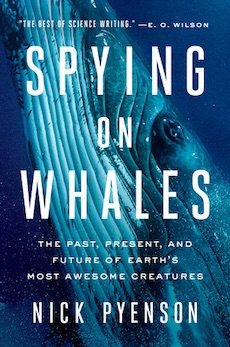Shortlisted for the 2019 ΦBK Science Award
By Louis J. Kern
Striving to classify whale species, Ishmael says he “grope[d] down into the bottom of the sea,” and “swam through libraries and sailed through oceans; I have had to do with whales with these visible hands” (“Cetology,” Moby Dick, Herman Melville). In analogous pursuit, Nick Pyenson, curator of fossil marine mammals at the Smithsonian, observes that “whales aren’t my destination . . . . I study whales because they tell me about inaccessible worlds, scales of experience that I can’t feel, and because the architecture of their bodies shows how evolution works.”
“Spying” combines elements of whale hunting, taphonomy, fossil examination, “biologging” (attaching a tracking tag recording speed and location), necropsy, and cetacean taxonomy. This volume is grounded in extensive personal experience, is enthusiastically narrated, and aptly conveys the excitement of scientific discovery.
Peyson divides leviathans into Rorquals—humpbacks, blue whales, fin whales, and minke whales, their baleen relatives (Mysticetes)—the gray and bowhead whales, the Ondontocetes, toothed whales—sperm whales, beaked whales, river dolphins, porpoises, and oceanic dolphins–and killer whales (Orcinus orca)—distinguished by their feeding practices—lunge-feeding baleen, echolocating toothed, and pack hunting killers.
Some 40-50 million years ago terrestrial ur-whales—Pakicetus, Maiacetus and Ambulocetus—evolved into a fully aquatic lifeform—the Basilosaurus, ancestor of killer whales. Over the course of evolutionary history, whales have experienced massive extinction; of 600+ species, only 80 currently remain. Their closest modern terrestrial relatives are hippos, but they are also related to hoofed animals—cows, deer, and pigs.
Pyenson takes the reader on an exciting tour of massive fossil beds (Cerro Ballena), an expedition tagging humbacks in the Antarctic, and on-site dissection of minke whales’ (Balaenoptera acutorostrata) throat pouches in Iceland, revealing important discoveries about cetacean behavior and evolution. Cerro Ballena, a unique fossil deposit, contains dozens of fully intact whale skeletons laid down in four geologic layers. Using data from contemporary whale strandings, Pyenson finds the most likely explanation for such massive die-offs at a single location on four discrete occasions is toxic alga blooms that drastically affect aquatic populations. Dissection disclosed a new sensory organ in the chin of rorquals that triggers the opening and shutting of the jaws during filter feeding.
Close observation and biologging data have revealed that whales form cooperative communities for hunting and that they have matrilineal societies. Humpbacks fish coordinately using a bubble net, emitted air bubbles that rise into a column, trapping prey. Killer whales hunt in packs. Whales are extraordinarily intelligent animals—oceanic dolphins and killer whales rank ahead of chimps and second only to humans, and those species are capable of mirror recognition. In their complex, multi-generational societies they communicate over vast distances in a humanly impenetrable language.
And yet in the Anthropocene, these magnificent animals, evolutionarily much older than ourselves, are at risk of extinction. Nineteenth-century whalers and their expanded impact in the twentieth century resulted in a loss of over 80% of humpbacks and 99% of blue whales. Though some species have managed to make some recovery, the IWC has failed in controlling whale exploitation. While the extinction of most species to have ever evolved cannot be particularized, current dangers are solely man-made—ship strikes, fishing net entanglement, loss of habitat, disappearance of food sources, toxic run-off, and global warming. Cetacean evolution spans 50 million years; some species may be able to adjust to drastically altered ecologies, but the overall future does not look promising. The loss of creatures of such magnitude and majesty would leave us much poorer in terms of some of the most fascinating mysteries left in the world and a deeper understanding of our place therein.
Louis J. Kern (ΦBK, Clark University) is professor emeritus of history at Hofstra University. Hofstra University is home to the Omega of New York chapter of Phi Beta Kappa.




